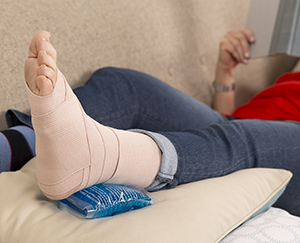Have someone drive you home after you have an endoscopic plantar fasciotomy (EPF). Your health care provider may want you to rest at home for a few days. Ask your provider when you can start walking again. If a compression dressing is used to control swelling, you may need to wear a surgical shoe. You may also need to wear a short leg brace for up to 3 weeks.
Recovering at home
Expect your foot to feel numb right after the surgery. You’ll probably feel some pain after the local anesthesia wears off. Ice your foot for 10 to 15 minutes several times a day to limit pain and swelling. Raise your foot above heart level as often as you can. If you've been given pain medicines, take them as directed.
Your first post-op visit
Your health care provider may want to see you 1 to 2 weeks after surgery. During this post-op visit, your incisions will be checked to make sure they are healing. The compression dressing may be replaced with a smaller surgical dressing. If this occurs, you can probably start wearing sneakers.
When to call your doctor
Call your health care provider if you have:
-
A bandage that is too tight.
-
A lot of swelling or numbness of your toes.
-
Pain not relieved by medicine.
-
More than a few drops of blood at an incision site.
-
Signs of an infection, such as:
-
A fever of 100.4°F (38°C) or higher, or as directed by your provider.
-
Chills.
-
Redness near the incision.
-
-
Skin color changes beyond the dressing.
Featured in


